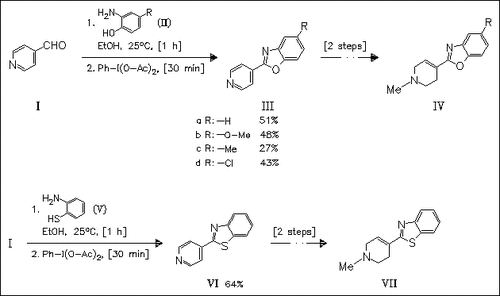ChemInform Abstract: Studies of Muscarinic Receptor Agonists: 2-(1-Methyl-1,2,3,6-Tetrahydropyridin-4-yl)benzoxazoles/benzothiazole.
Abstract
ChemInform is a weekly Abstracting Service, delivering concise information at a glance that was extracted from about 100 leading journals. To access a ChemInform Abstract of an article which was published elsewhere, please select a “Full Text” option. The original article is trackable via the “References” option.
ChemInform Abstract
Condensation of 4-pyridinecarboxaldehyde (I) with p-substituted o-aminophenols (II) or o-aminothiol (V) gives the corresponding Schiff′s bases, which are stable and can be isolated but are directly transformed by oxidative intramolecular cyclization in a one-pot process to give compounds (III) and (VI), respectively. Their partially hydrated derivatives (IV) and (VII) as well as their appropriate hydrochloride salts are examined for their binding affinities to the M1 subtype of muscarinic receptor by the [3H]-NMS binding assay.





